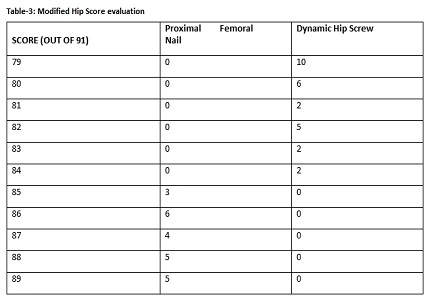Comparison of dynamic hip screw and proximal femoral nail in the treatment of Intertrochanteric fracture of femur
Abstract
Introduction: As the elderly population grows, the number of hip fractures continues to increase. This study aims to compare the clinical outcomes of DHS and PFN in the fixation of intertrochanteric fracture of femur.
Methodology: After obtaining approval of the ethics committee, a prospective study was conducted in the Department of Orthopedics, DY Patil School of Medicine from January 2014 till December 2015. Informed consent was taken from from patients who fulfilled the inclusion/exclusion criteria and relevant clinical information was collected, including intra and post-operative details. The patients were called for followup to check for complications.
Results: During the study period, 50 patients with intertrochanteric fracture were included in the study, of which 23 were treated ith PFN and 27 with DHS. 76% of the PFN patients needed no blood transfusion, while 41% of DHS patients needed 2 units of blood transfusions. Post operative fever and deep vein thrombosis was more common in DHS patients. 79% of PFN patients started mobilizing on the first postoperative day as compared to 68% of DHS patients who starting mobilizing on third postoperative day. Similarly post operative weight, full weight bearing and return to activity of daily living was seen to be better in PFN patients.
Conclusions: Our study showed that PFN is a superior method of osteosynthesis as compared to DHS in the treatment of intertrochanteric fractures. Future research should focus on studying the economic and rehabilitative impact of PFN on patients with intertrochanteric fractures.
Downloads
References
2. Waters PM, Millis MB. Hip and pelvic injuries in the young athlete. Clinics in sports medicine. 1988;7(3):513-26. [PubMed]
3. Radford P, Needoff M, Webb JK. A prospective randomised comparison of the dynamic hip screw and the gamma locking nail. Bone & Joint Journal. 1993;75(5):789-93. [PubMed]
4. Bogosavljević M, Stokić D, Friščić Ž, Ristić BM. Unstable intertrochanteric fractures: How to prevent uncontrolled impaction and shortening of the femur. Vojnosanitetski pregled. 2011;68(5):399-404.
5. Streubel PN, Moustoukas MJ, Obremskey WT. Mechanical failure after locking plate fixation of unstable intertrochanteric femur fractures. Journal of orthopaedic trauma. 2013;27(1):22-8.
6. Boyd HB, Griffin LL. Classification and treatment of trochanteric fractures. Archives of Surgery. 1949;58(6):853-66. [PubMed]
7. Broos PL, Bisschop AP. Operative treatment of ankle fractures in adults: correlation between types of fracture and final results. Injury. 1991;22(5):403-6.
8. Modified Hip Score. Available http://www.losangelessportssurgeon.com/pdf/modified-harris-hip-score.pdf Accessed February 15, 2017.
9. Friedman RJ, Wyman Jr ET. Ipsilateral hip and femoral shaft fractures. Clinical orthopaedics and related research. 1986;208:188-94.
10. Bhakat U, Mukherjee A, Bandyopadhyay R. Comparison between Distractor Application on Both Radial & Ulnar Side and Radial Side Only for Fracture Distal Radius with Ulnar Styloid Fracture. Open Journal of Orthopedics. 2013;3(05):227.
11. Gupta SV, Valisetti VS. Comparative study between dynamic hip screw vs proximal femoral nailing in inter-trochanteric fractures of the femur in adults. International Journal of Orthopaedics. 2015;1(1):07-11.
12. Kurup H, Hossain M, Andrew JG. Dynamic compression plating versus locked intramedullary nailing for humeral shaft fractures in adults. The Cochrane Library. 2011 Jan 1.
13. Utrilla AL, Reig JS, Muñoz FM, Tufanisco CB. Trochanteric gamma nail and compression hip screw for trochanteric fractures: a randomized, prospective, comparative study in 210 elderly patients with a new design of the gamma nail. Journal of orthopaedic trauma. 2005;19(4):229-33.
14. Pajarinen J, Lindahl J, Michelsson O, Savolainen V, Hirvensalo E. Pertrochanteric femoral fractures treated with a dynamic hip screw or a proximal femoral nail. Bone & Joint Journal. 2005;87(1):76-81. [PubMed]



 OAI - Open Archives Initiative
OAI - Open Archives Initiative


















 Therapoid
Therapoid

